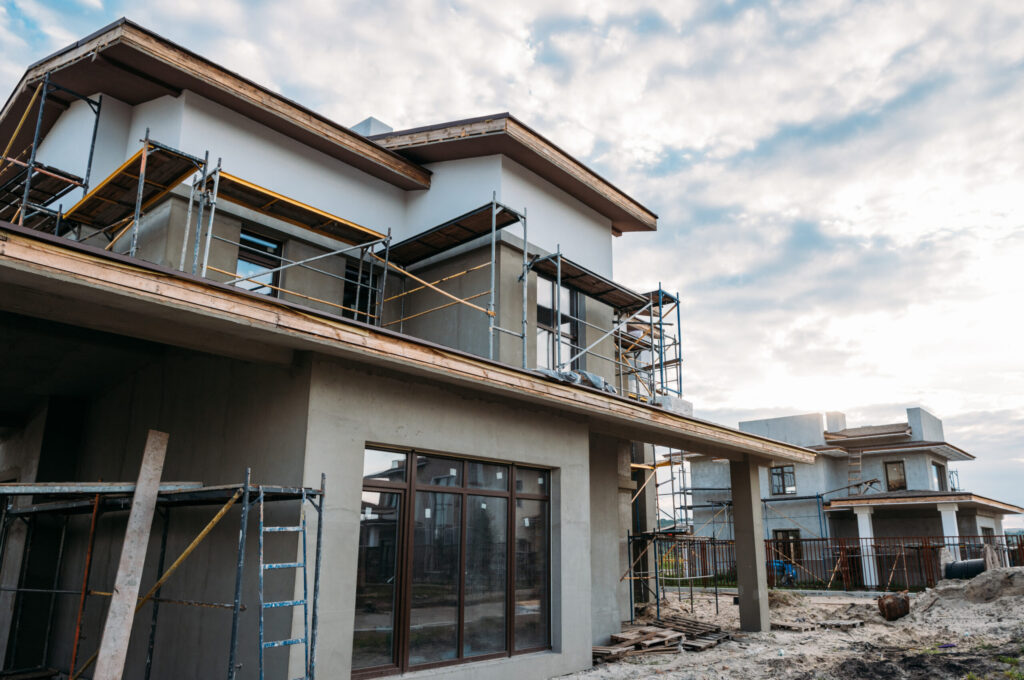
How Bridge Loans Manage Construction Cash Flow
You’re running three builds simultaneously when your bank delays the next draw by two weeks. Your concrete supplier demands payment upfront, your framing crew threatens to walk, and material costs jumped fifteen percent overnight. Sound familiar?
This scenario hits builders daily across construction sites. With lumber prices swinging weekly and subs demanding faster payments, traditional construction financing can’t match the pace of real building schedules. Understanding how to manage cash flow in construction requires strategic approaches that address both immediate liquidity needs and long-term financial stability.
The Multi-Project Cash Flow Reality
Multi-project operations create timing gaps between when you pay for materials and labor versus when banks release draws. Cash flow management becomes exponentially complex when construction companies juggle multiple projects simultaneously. This timing mismatch typically results in substantial losses for builders through emergency funding premiums and delayed payment penalties.
Effective cash flow management requires more than careful budgeting. Construction companies face unique cash flow challenges that create negative cash flow patterns, particularly when project costs accumulate faster than revenue streams from completed milestones. Managing cash flow across multiple construction projects requires strategic financing tools that align with the unpredictable nature of construction work.
While banks process draws on monthly schedules, bridge loans activate within 24-48 hours of milestone completion. This rapid response prevents the funding delays that force builders into premium emergency financing situations and strain cash flow.
Cash flow challenges paralyze even experienced builders when money gets trapped in one project while another demands immediate funding. Your entire operation stops when traditional construction loans can’t accommodate builders managing multiple developments simultaneously, creating gaps that devastate project timelines and strain subcontractor relationships.
The three-step approach to fixing liquidity problems starts with understanding your exposure and securing appropriate backing:
- Calculate peak working capital gap across all active projects.
- Secure bridge capacity at 1.2× your maximum exposure.
- Set up automated draw triggers tied to completion milestones.
This systematic approach provides a foundation for predictable cash flow management across multiple projects, while enhancing cash flow efficiency.
Critical Pressure Points Every Builder Faces
Five interconnected factors create cash flow challenges that compound across multiple construction projects. These cash conversion cycle disruptions make cash flow projections increasingly difficult while increasing exposure to negative cash flow periods that can damage subcontractor relationships and project momentum.
Each pressure point creates specific timing challenges that construction companies must address through strategic financing and operational planning:
- Material Purchase Timing: Bulk ordering for multiple projects ties up significant capital before revenue generation begins, creating procurement timing mismatches that strain cash flow and working capital reserves.
- Labor Allocation Conflicts: Competing project deadlines force premium overtime payments and skilled trade bottlenecks that strain cash flow through elevated payroll costs and emergency staffing premiums.
- Permit Delays: Staggered approval processes create uneven cash outflows while maintaining fixed overhead costs, disrupting planned disbursement schedules, and creating temporary funding gaps that affect cash flow.
- Subcontractor Payment Schedules: Misaligned payment terms with different trades create temporary but significant cash shortages when pay-when-paid clauses don’t align with draw timing from primary lenders.
- Change Order Processing: Delayed approvals for modifications disrupt planned cash flow patterns across active projects, often requiring immediate cash outlays before reimbursement through formal change order processing.
Lenders who understand these cash flow issues provide more than funding. They offer strategic guidance on timing material purchases, structuring payment terms, and managing change orders to minimize cash flow disruption and improve cash flow stability.
Bridge Loans as Strategic Solutions for Construction Cash Flow
Bridge loans eliminate timing gaps between project costs and traditional bank disbursements when builders need immediate cash flow. These short-term financing tools provide access to working capital during critical phases when conventional draw schedules lag behind actual construction expenses. This approach prevents the funding delays that typically force emergency financing at premium rates and create negative cash flow.
While banks require extended periods for draw processing, bridge loans close in 24-48 hours. Builders maintain project momentum during bank delays that would otherwise shut down operations and damage subcontractor relationships, helping to maintain positive cash flow throughout construction projects.
Bridge financing provides immediate cash flow for materials, labor, and unexpected expenses while permanent financing processes remain pending. These specialized financing approaches address the fundamental timing mismatches between when you pay suppliers and subs versus when banks release draws based on milestone completion, directly impacting construction cash flow.
Bridge financing provides immediate cash flow for materials, labor, and unexpected expenses while permanent financing processes remain pending. These specialized financing approaches address the fundamental timing mismatches between when you pay suppliers and subs versus when banks release draws based on milestone completion, directly impacting construction cash flow.
Construction industry professionals who master cash flow management through bridge financing typically maintain more substantial cash reserves and avoid the cash flow problems that derail project timelines. This financial stability allows construction companies to focus on project completion rather than managing cash flow crises.
Bridge loan eligibility centers on three key criteria that indicate when short-term financing provides the most value for construction cash flow:
- Project timeline gaps exceed 14 days between the completion of milestones and bank funding.
- Working capital needs exceed 25% of the monthly cash flow.
- Multiple active projects require staggered resource allocation.
These criteria help builders identify when bridge financing offers the most strategic benefit for managing cash flow effectively.
Pre-Approved Credit Frameworks That Work
Pre-approved bridge loan limits eliminate the approval delays that traditionally disrupt construction cash flow during critical project phases. Your construction company’s cash flow improves dramatically when credit facilities activate automatically based on specific milestones rather than requiring individual loan applications for each funding need.
Pre-approved frameworks activate credit within hours of milestone completion, not weeks. This eliminates the documentation delays that force builders into emergency financing situations and create cash flow gaps that can strain cash flow across multiple projects.
Understanding construction phases enables experienced lenders to structure automatic triggers around key milestones, such as foundation completion, framing, and final inspections. These are the critical points where cash flow typically tightens and construction companies need immediate access to cash reserves.
Construction operations benefit from this strategic approach because it maintains project momentum while protecting overall financial health throughout the building process. Auto-disbursement triggers tied to completion certificates eliminate documentation delays and reduce funding lag to under 48 hours, compared to typical bank processing cycles that can strain cash flow.
Optimizing Draw Schedules for Real-World Construction
Synchronize bank draw timing with actual construction milestones to eliminate the funding gaps that create negative cash flow. Deploy a four-step Draw Sync process that triggers automatic disbursements upon milestone verification. This coordination prevents the liquidity crunches that force premium emergency financing and subcontractor payment delays.
While banks process draws monthly, milestone-based systems trigger funding within 5 business days of completion. This alignment prevents the working capital gaps that shut down active projects and helps maintain positive cash flow throughout construction projects.
Effective cash flow management through optimized draw schedules prevents the cash flow challenges that traditionally occur between completed work phases and bank disbursements. Strategic timing transforms how construction companies manage cash flow by ensuring funds arrive exactly when project costs demand payment.
Experienced lenders understand that roofing crews can’t wait three weeks for draw approval when weather windows are closing. Milestone-based approaches respect construction realities and seasonal constraints while maintaining steady cash flow.
The four-step Draw Sync process creates predictable funding patterns that align with construction reality and improve cash flow:
- Create a milestone plan with specific completion triggers and evidence requirements.
- Prepare evidence packages 5-7 days before projected milestone completion.
- Submit draw requests within 24-48 hour windows after milestone verification.
- Bridge backfill any gaps exceeding 5 business days until bank disbursement.
This systematic approach eliminates the guesswork and delays that typically plague construction financing, helping construction companies maintain healthy cash flow.
Milestone-Based Draw Optimization
Auto-disbursement triggers eliminate verification lag while completion certificates provide immediate evidence for bank processing. This systematic approach maintains cash flow forecast accuracy within tight variance parameters while reducing average funding lag to under 5 business days. Builders using milestone-based systems report substantial improvement in working capital efficiency compared to calendar-based draw schedules.
Construction cash flow projections become more accurate when bridge financing supplements traditional construction loans during gaps between principal milestone payments. This layered financing approach provides working capital during intervals when project completion percentages don’t align with immediate operational expenses, helping maintain positive cash flow.
Precise coordination with construction milestones ensures that funding delays, which traditionally affect cash flow during critical project phases, are eliminated. This systematic approach to managing cash flow ensures construction projects maintain their schedules while protecting overall financial stability.
Target KPIs for draw optimization establish clear performance benchmarks for construction cash flow:
- Funding lag ≤5 business days from milestone completion.
- Cash flow forecast variance <2% monthly.
- Evidence package completeness rate ≥98%.
These metrics help construction companies track improvement and maintain consistent performance in cash flow management.
Next Steps for Better Cash Flow Management
Implement a systematic action plan with specific owners and measurable KPIs to optimize construction cash flow management. Begin with portfolio cash flow auditing, then layer in financing solutions and operational improvements. This systematic approach delivers immediate improvements while building long-term financial resilience and maintaining positive cash flow.
Strategic bridge financing emerges as a critical tool in navigating the unpredictable terrain of construction economics. Effective cash flow management requires more than reactive problem-solving; it demands a proactive approach that anticipates potential bottlenecks, leverages financing technologies, and maintains flexibility across project portfolios.
When traditional lenders create bottlenecks in construction timelines, bridge financing provides the tactical flexibility to maintain momentum across multiple projects while protecting subcontractor relationships and overall financial stability. This approach to managing cash flow ensures construction companies can focus on project completion rather than financing delays.







